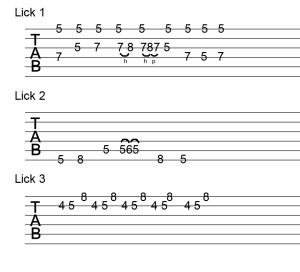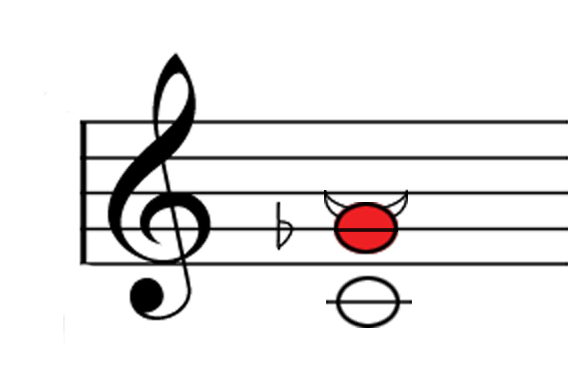I hope that you’ve spent some time exploring tensions and resolutions of each of the individual notes for each chords. The next note is tense for all three chords, but an absolutely essential blues note.
The Flat 5
Ok, the past two lessons were “scales” and frequently the next step for many guitarists is to add in “The blues scale” which is nothing other than the minor pentatonic with the flat 5 added in. I’m going to propose the radical idea of it being the first added note.

TT. Tritone. The Devil’s 3rd. Augmented fourth / diminished fifth. Diabolus in musica. Play the root and then the flat 5. Play them together. This “evil” sounding interval was listed as a sound to be avoided in Medieval music and picked up the sinister reputation in the early eighteenth century. In a future lesson about chords, I’ll show how this interval is essential to the blues harmony, but right now we’re just looking at adding this note to our soloing vocabulary.
I mentioned earlier that this is a tense note for all three chords, but it’s a beautiful “ornament” or passing tone for all three chords. Part of my approach with this series of lessons is not to give you a bunch of licks, but the tools to make your own. But I’ll make an exception right now to give you some idea of how beautiful this ugly note can be for the blues.

So, spend a bit of time with this particular note for all three chords, but I find that for all three it’s perfect as something to move through or away from and not usually a note to “stick”. On the one chord, as you see with the above licks, the note works fine going to the 4 or the 5. You can use it on a run up or down between those notes. On the five chord, if you land on it, you can either move a half step down (the b7 of the V chord) or a half step up, but there is a bit more gravity going up (to the root of the V chord). On the IV chord, landing on this interval generally wants to move down a half step ( to the root of the IV chord)
Anyway, long winded way of saying it’s tense on all three chords, but it’s good.
So after taking time working this one in, we should now have nine out of twelve notes under our fingers and in our heads for improving over a blues.

